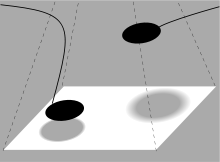BURN-IN AND DODGING
BURNING-IN - increasing the amount of exposure
- On occasion, the contrast in some negatives is so extreme that it is difficult to get good detail in the highlights without over-exposing the shadows.
- The highlights can be burned-in by simply giving the whole print the correct exposure, then masking all but the highlights, while a further exposure is made.
- Burning-in can be achieved by cutting appropriately sized holes in opaque card to allow areas of the print to receive more than the main exposure.
- Hands can also be used for this purpose. It is important to keep the object, of the hands, moving at ll times in order to avoid getting a line around the dodged area.
DODGING - decreasing the amount of exposure
- This process involves shading areas of the print during exposure so that they receive less light and come out brighter.
- Dodging can be achieved by sticking a piece of opaque card onto thin wire and use this to mask the requisite area of the print.
- It is important to keep the mask moving gently throughout the exposure.
|
Acknowledgement:
Tutor: Peter Perry These notes are an accumulation of those written by myself - or obtained from the College during the course.
This is not a commercial site. |
Polly Healy - Course Work : 2000
SOUTH THAMES COLLEGE, LONDON, SW18 2PP ______________________________________________________ Copyright: THE SMOOTH GUIDE TO PHOTOGRAPHY - How to get started ... [email protected] _____________________________________________________ See other Smooth Guide sites: www.animalsandenglish.com www.englishlanguagetips.com www.smoothguide-mahjong.com www.smoothguide-internetfundamentals.com www.smoothguide-kenyacoast.com www.healyshandyhouseholdhints.com www.smoothguide-sunbury.com |
